Introduction
- A curriculum can be defined as an outline in which learners receive information provided through different methods, assessment and instructions in schools (Oliva, 2009).
- Curriculum should be developed effectively to meet the needs of learners.
- Curriculum developed should significantly suite all the levels of graded elementary and non-graded schools.
- Definitely, there are principles that are used to develop a curriculum in every institution.
Apparently, curriculum provides learners with exposure to different aspect of learning for them to gain skills and knowledge. Meanwhile, an appropriate curriculum follows a specific pattern that is prescribed by teachers (Oliva, 2009).. In this case, this is not governed by level of growth and development but by the ability to meet certain standards specified in various field of instructions. when developing the curriculum, teachers and educational practitioners might come up with ideas regarding the projects, activities and ideas that will be incorporated in a curriculum. Curriculum development may involve a group of staffs who are skilled such as district supervisors, curriculum councils and other chairpersons who acts as steering committee. However, there are hypothetical several steps that are being followed in developing a curriculum (Oliva, 2009).
Usually, curriculum is developed through a combined effort of both the learners and staffs. Essentially, the subject matter is based on learners needs though in some case, the teacher can reinforce or suggest certain activities for the learners. Nevertheless, students’ interests become the common factor of consideration when developing a curriculum (Oliva, 2009).
Meanwhile, curriculum can not be developed fully at a go. Much time is taken to consider content needed progressively. Definitely, it is only when a certain procedure is accomplished in the development that they can be described. There are several types of curriculum such as activity, teacher-centered, learner-centered, graded and non-graded type. Nevertheless, regarding the fact that all the types are involved in learning, they follow the same procedure (Oliva, 2009).
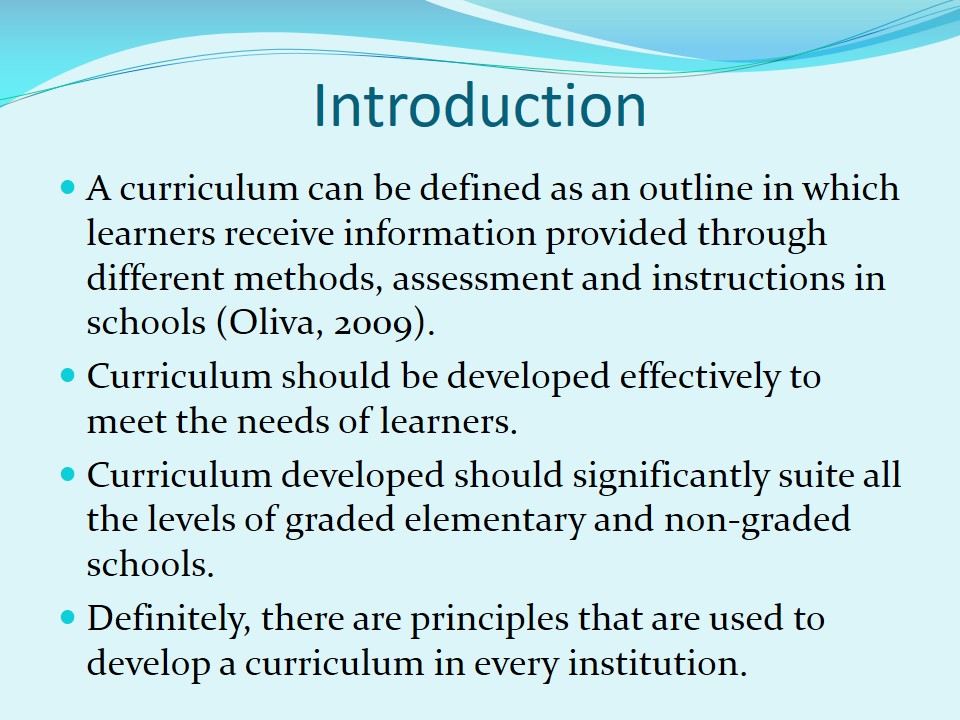
Hypothetical procedures in curriculum development
- Setting of Goals and Objectives.
- Assessment of learners’ needs.
- Planning e.g. for raw materials.
- Content development.
- Piloting and Revising the curriculum.
- Curriculum packaging.
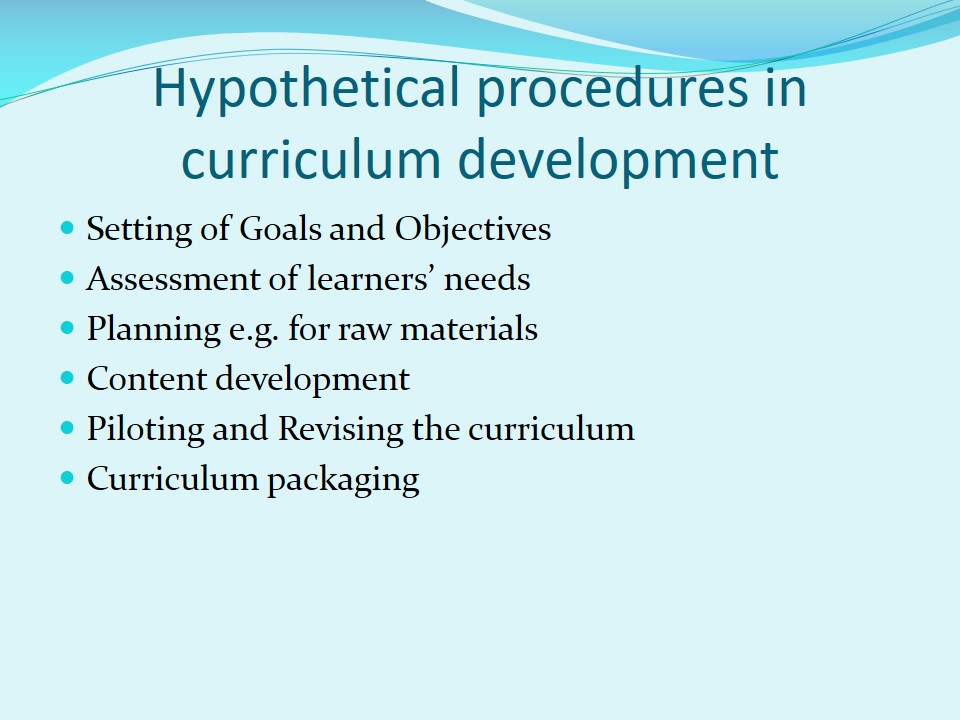
Goals and Objectives
- Team members include faculty members, lay people, students and teachers.
- These goals help in creating a competent curriculum that will make educational experiences all-round to benefit learners in all aspects.
- Initially, there is need for the persons concerned to lay down goals and objectives that need to be met in the process of developing a curriculum.
- In the process, faculty members, lay people, students and teachers are involved in setting goals and objectives.
This also helps learners, administrators, supervisors and lay people to understand the concepts in the curriculum and work toward the goals. Notably, set goals and objectives provide a foundation for the next step in curriculum development (Oliva, 2009).
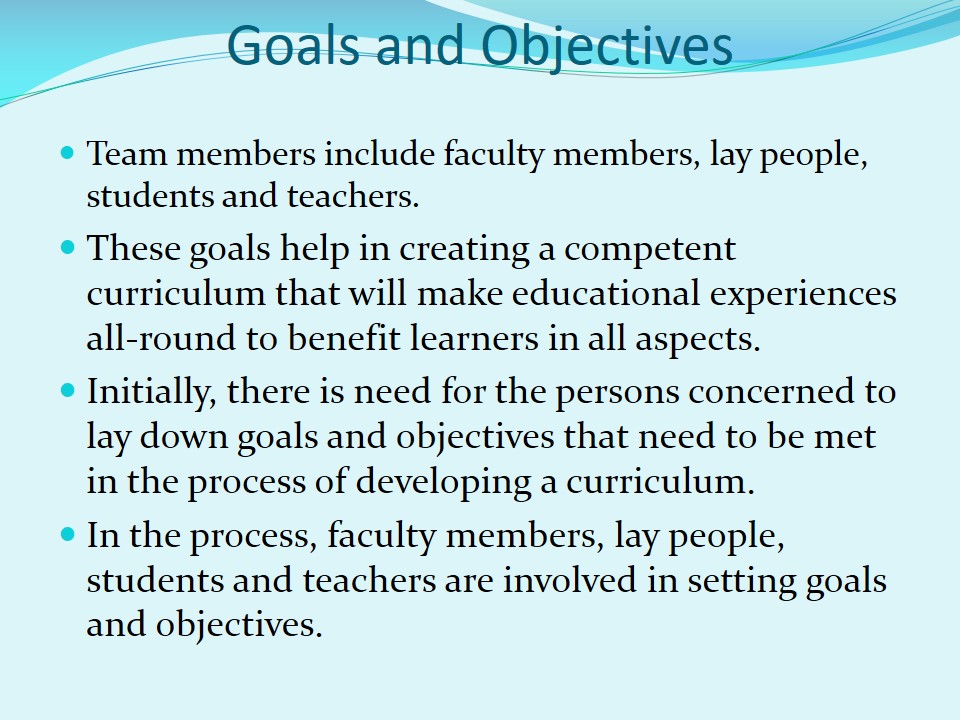
Needs assessment
- What to consider in the assessment.
- Importance of needs assessment.
- Apparently, it is important to note that before the curriculum is developed, an assessment is conducted among the schools targeted to be considered in a particular district.
- During the assessment test, a report is released to explain the differences and gaps among schools involved.
- Curriculum assessment is one of the hypothetical steps involved in developing a curriculum.
- Assessment involves monitoring the patterns followed through curriculum in order to identify whether the set objectives and goals have a positive or a negative output to learning.
- When conducting an assessment, it is advisable to consider the needs of learners.
- Moreover, when need assessment is conducted, it enables the team involved to get an overview of the expectations for the upcoming curriculum.
Certainly, there are possible questions that one should ask himself after conducting the assessment and laying down the goals of a curriculum. Specifically, it is worth to question on how the goals and objectives laid will be enhanced in real process of learning. In this case, setting goals and objectives should be associated with significant actions. This bring us to the point that there is need to create a link between the set goals and assessment methods to be used in examining the curriculum (Oliva, 2009).
By doing this, several questions are answered. This include how long will the goals be envisioned and their purpose in learning. Assessment also helps to estimate the outcomes of the laid goals and objectives (Oliva, 2009).
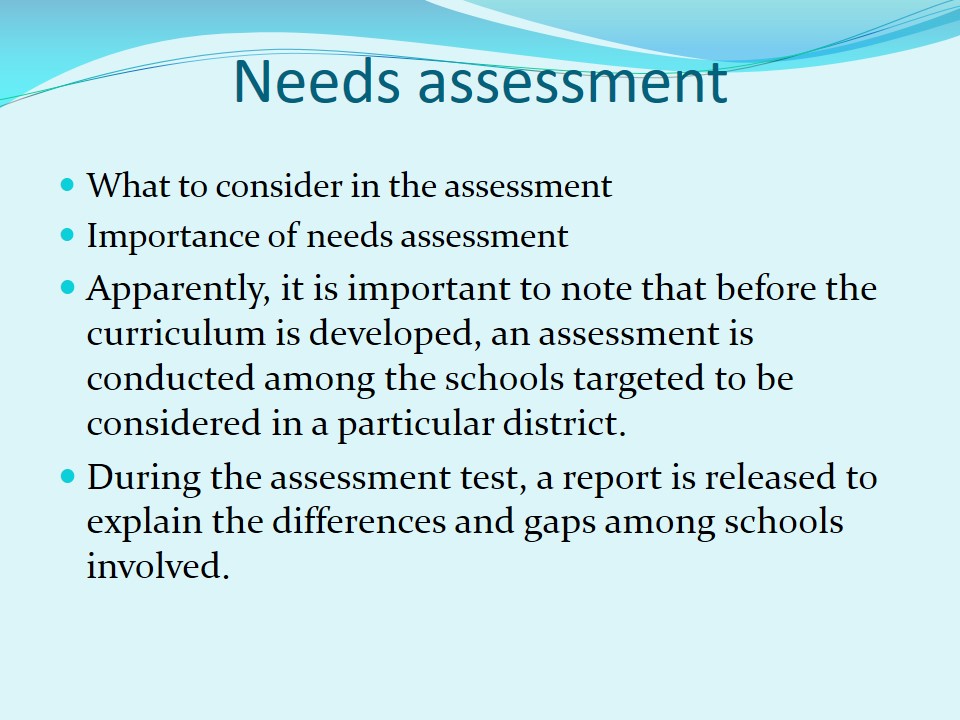

Planning
- Planning is a vital aspect in curriculum development especially for new schools.
- However, it needs to be conducted within specified limits in which other schools should participate.
- Parameters considered when planning such as learners needs, administrators values and financial resources.
- Specific requirements that need to be incorporated include stationeries and recreational facilities.
There are certain parameters that must be considered when planning for a curriculum. These include considering learners needs, administrators values, financial resources available, teachers preferences and physical restrictions from the environment (Oliva, 2009). There are specific requirements that need to be incorporated in the program. These involve educational facilities in terms of stationeries and recreational facilities. This requires active participation of team members to establish the content and subject matter to be included in the curriculum. However, it is important to include only those persons who are qualified and thus are aware of the learners needs. They also need to be conversant with the objectives and expectations of the curriculum being developed. During planning sessions, the team members should clarify and establish a concrete outline on the area of focus, expectations, methodologies and frames for absolute accomplishment of the curriculum (Oliva, 2009).
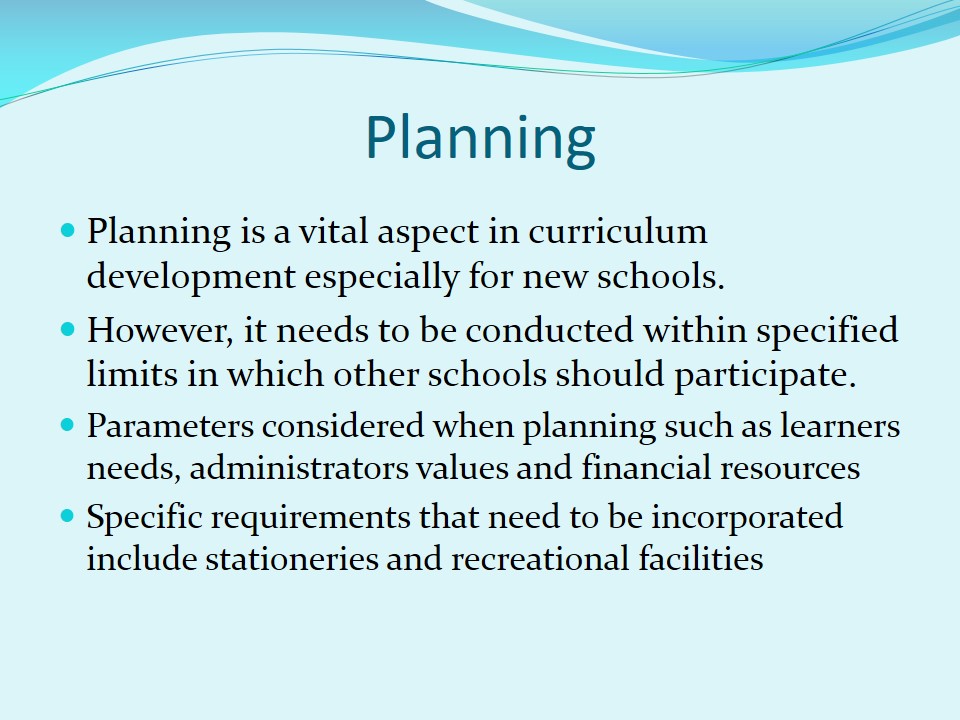
Content Development
- Content is developed depending on set goals and objectives.
- Content development varies across grades of study.
- It provides a framework in which instructional methods are offered.
- This step should be lengthy in order to successfully design, allocate and complements the necessary participant and study materials.
The fourth step involves developing the content in the curriculum. At this point, the team defines the content of each area of the curriculum depending on the laid objectives and goals. It is worth to note that, each goal provides a framework in which instructional methods are formulated. As a result, resources are allocated depending on the lesson plan and other activities that have been developed by the curriculum developers. Moreover, content development varies across the grades of study. For example the content of the curriculum for elementary students differs with that of grade 5 and above (Oliva, 2009).

Piloting and Revising the curriculum
- Target audience like the professionals validate the lesson plans, training aids and other resources used in the curriculum.
- Having already developed the content, the curriculum is piloted to professionals who validate the goals, instructional methods, contents and objectives.
- The evaluators investigate on whether the curriculum meets the needs of learners and society at large.
This procedure acts as a test drive to examine whether the curriculum meets the requirements (Oliva, 2009). At this juncture, the evaluators investigate on whether the curriculum meets the needs of learners and their society. They also check on what the curriculum focuses on in its action plan. Sequentially, they check on the participation manuals to find if they are relevant to give adequate guide to learners and examine the effectiveness of training materials. This procedure provide room for the curriculum to be revised incase it is found wanting (Oliva, 2009).

Curriculum packaging
- This step gives the curriculum the mandate to be delivered to target audience.
- At this point, institutions can now recruit and train facilitators.
- This ensures that adequate knowledge is equipped to them in order to implement the curriculum.
- Curriculum is implemented toward achievement of preset goals and objectives.
Finally, the curriculum is packaged as complete after being piloted and revised. At this point, it can now be delivered to the target audience who are the learners. It is worth to note that, after the curriculum is declared varied institutions can now recruit and train facilitators. After this, the curriculum is implemented toward the achievement of laid goals and objectives (Oliva, 2009).
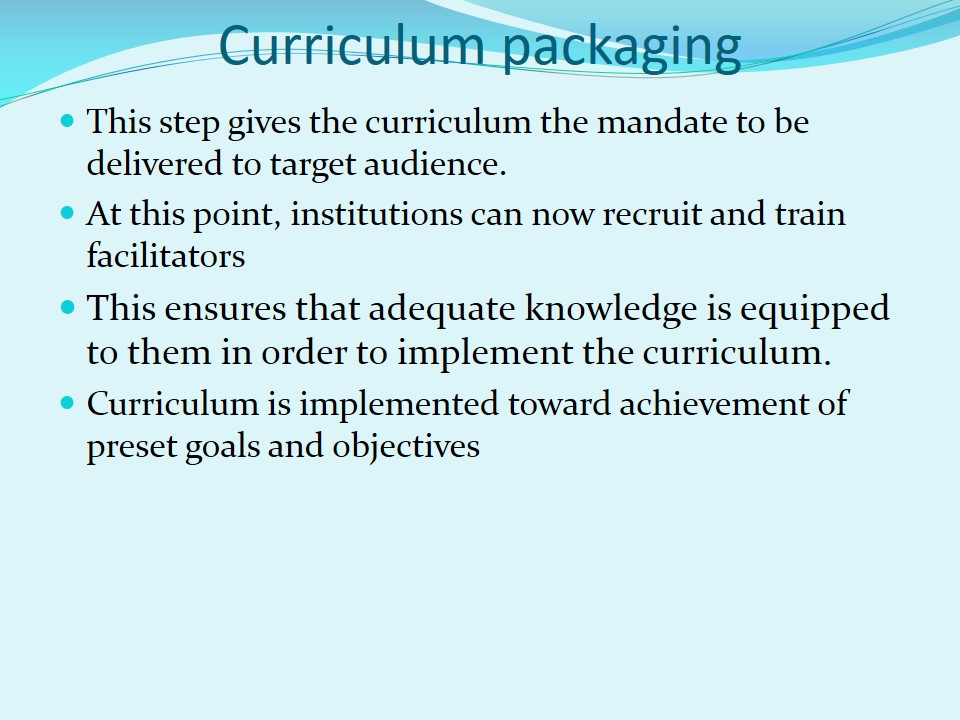
Graded curriculum
- Graded Elementary schools originated in Prussia and later spread to the new world and are completely graded in levels 1-12.
- Its imperative to note that curriculum development is not inclined to one level.
- For instance in the graded and has more than one level of study and therefore, the curriculum developed should suite all of them.
- In this case, the curriculum made should possess distinctive features for all levels of graded elementary and non-graded high schools.
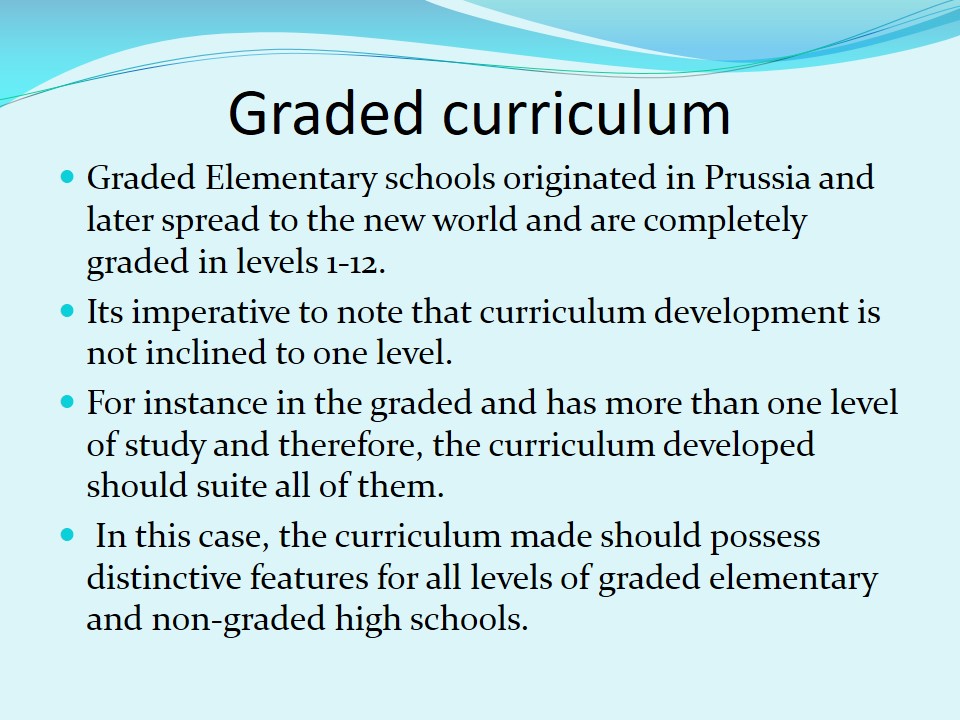
Non-graded curriculum
- Non-graded schools are those with firmly set principles.
- Learners must accomplish learning by the end of certain grade levels
- Non-graded schools include universities, colleges and high schools.
- The curriculum made should possess distinctive features that suite this type of curriculum.
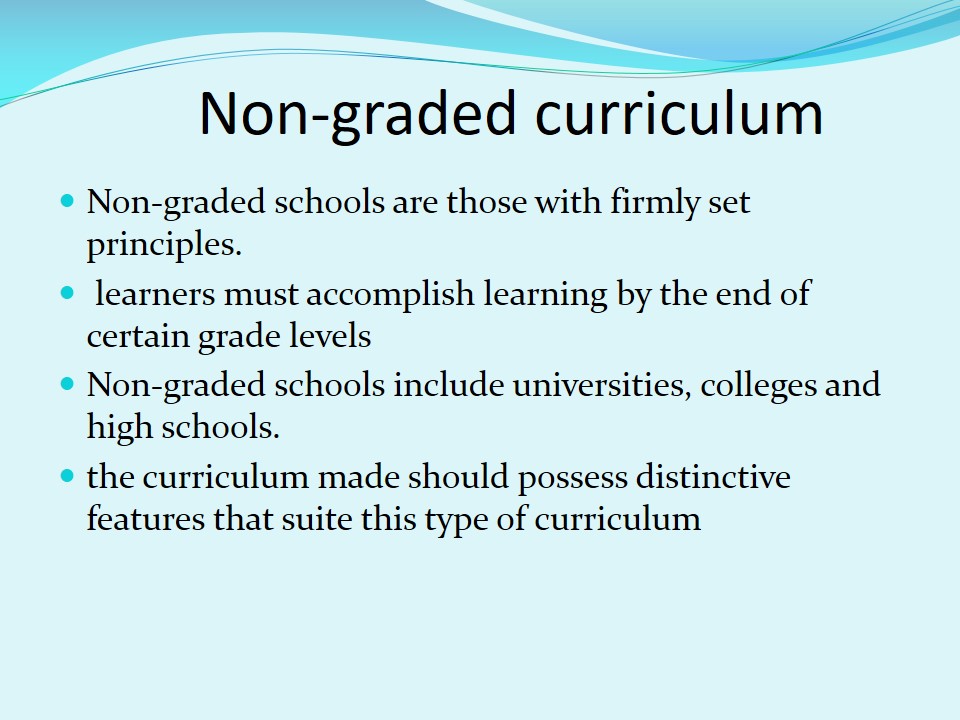
Activity Curriculum
- There are specific aspects that should be considered when developing a curriculum.
- For instance, in order to eliminate the rigidity in the graded and non-graded schools, an activity curriculum should be developed.
- In this essence, this curriculum was aimed at freeing the learners from a subject-centered curriculum.
- According to Dewey, activity curriculum in schools fosters reflective thinking.
According to philosophers, subject-centeredness focuses on engaging learners in occupations like cooking and carpentry. However, it is important to engage the learners in practical activities in the curriculum to increase their skills taught in classrooms.

Open Education Curriculum
- This form of curriculum allows learners to make choices for themselves.
- It serves the learners’ interests.
- Teacher act as a facilitators of learning.
- This facilitation entails allocating resources, planning and exploring concepts to be learnt in class.
- This curriculum allow learners to develop their potentials both personally and as teams.
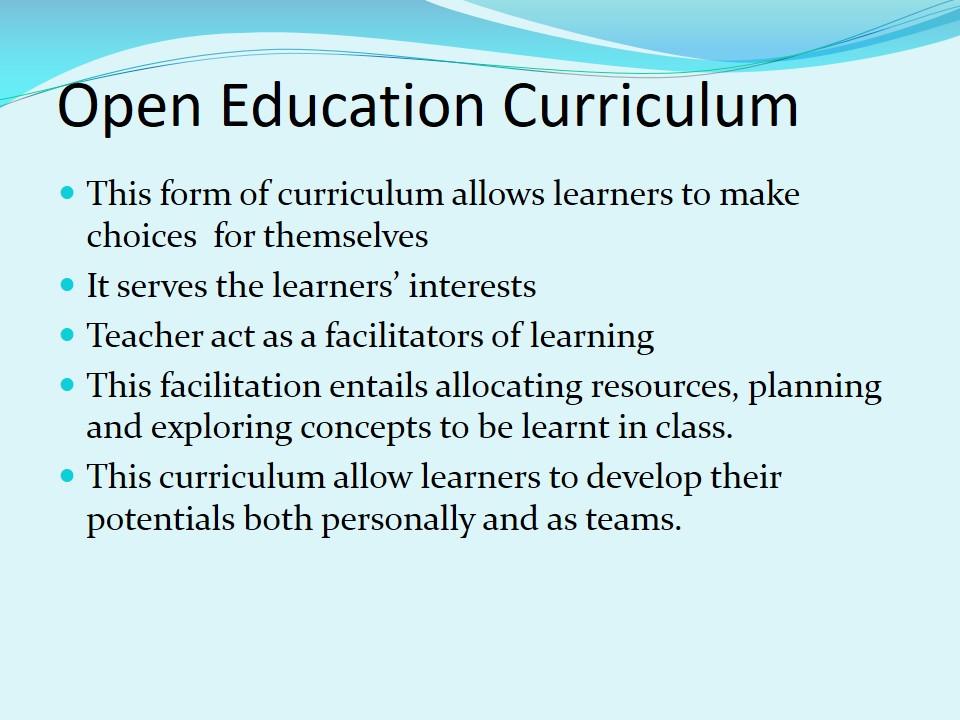
Open Space Curriculum
- Has different goals and dissimilar strategies of attaining them.
- It appeals to learners’ interest depending on their intellectual level.
- Organizing learners into flexible groups allow effective interaction with their teachers.
- However, this system is not very effective and has been taken over by graded and non-graded curriculum.
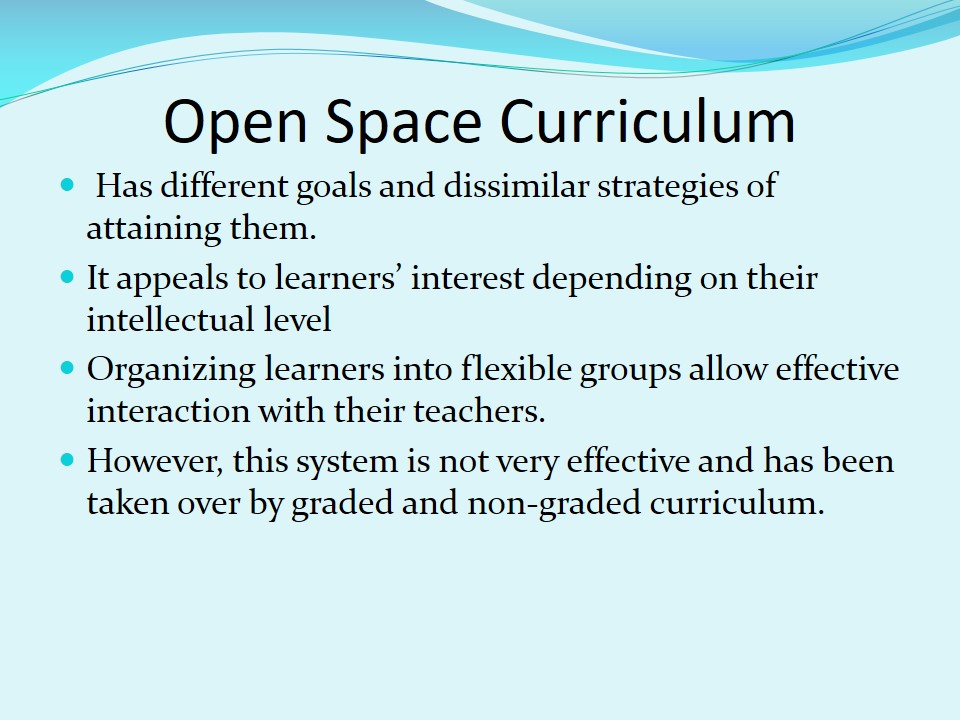
Subject matter in curriculum development
- The teaching staff should suggest which activities suit targeted learners though their interest should be the common factor.
- This fosters open education whereby the teacher acts as a facilitator of learning where learners self-direct themselves according to their interests.
- This calls for cooperation between learners and teachers.
- The above is crucial in developing a holistic curriculum that addresses both current and future needs of learners and tutors.
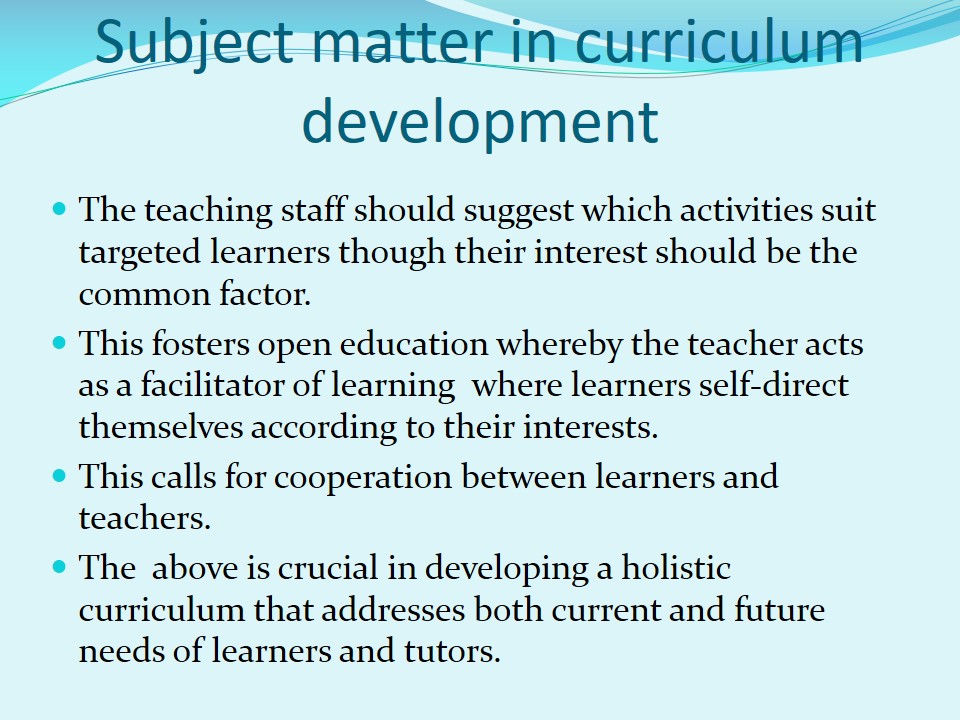
Conclusion
- Curriculum development is a vital activity.
- Curriculum should be self-sufficient and meaningful to learners.
- An effectual curriculum should be subjected to all the hypothetical steps.
- Proper and active roles should be played by staffs and learners in order to realize the expectations laid for the curriculum.
- Content of a curriculum should be self-sufficient and meaningful to learners. An effective curriculum development integrates the needs of learners.
To recap it all, curriculum development is a vital activity in the fact that, it ensures that learning in institutions take place in a systematic manner (Oliva, 2009). Effective development eventually leads the team to meeting their set goals and objectives in learning. Advisably, an effectual curriculum should be subjected to all the hypothetical steps that involve setting of goals, needs assessment, planning, and content development among others (Oliva, 2009).
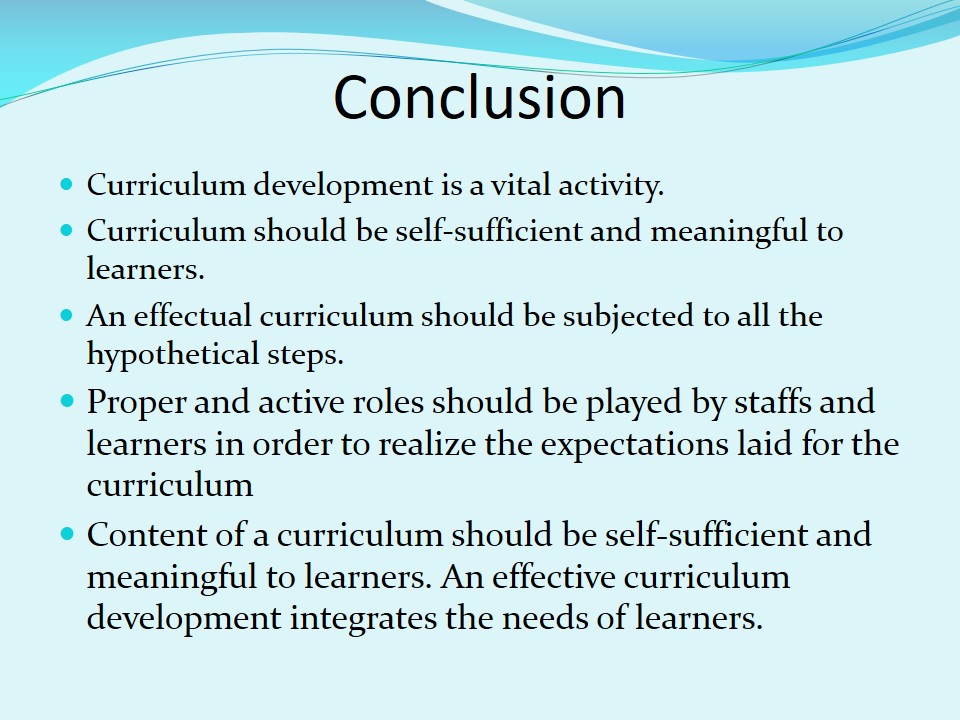
Reference
Oliva, F. (2009). Developing Curriculum. Virginia: Allyn & Bacon, Inc.